4.2 Lights and Shapes
As stated in the introduction, as well as defining the Rules of the Road, the IRPCS define (in considerable technical detail) the lights that vessels are expected to display at night time and in poor visibility, and the day time shapes they are expected to show.
A number of the rules in the previous section relate to what the each vessel is doing and what type of vessel it is. So vessels display that information for the benefit of other vessels, by day and by night, so that other vessels can take the correct action.
So skippers have the responsibility of displaying the correct lights and shapes in different circumstances, and also of being able to interpret those of other vessels. The purpose of this section is to tell you about the different lights and their meanings. As ever, refer to the text of the IRPCS (see our recommendation in the Introduction) for definitive detail.
Visibility of Lights (RULE 22)
The IRPCS define the brightness of lights, according to the type of light and size of vessel, and you should refer to them if you are fitting lights to your vessel.
This information is outside the scope of this Theory Class however, because skippers will not normally need it, and it would be quite a demanding (or mean?) Yachtmaster Examiner who would ask for it.
Types of Light (RULE 21)
Most vessels require several different types of light, and the six types are described below (sailing yachts need to display the first four at various times, depending on what they are doing).
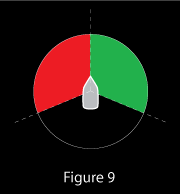
Sidelights
Sidelights are: a green light on the starboard side and a red light on port. Each light shines in a sector from dead ahead to 22.5 degrees aft of the beam.

Sternlight
A sternlight is a white light at the stern of the vessel, shining astern, in a sector from 22.5 degrees aft of the beam on one side to the same angle on the other side. See Figure 10.
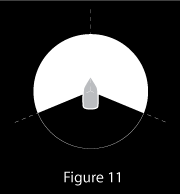
Masthead light
A masthead light is a white light which shines forward. It is generally situated high up on the vessel's mast. It can be seen in a sector from 22.5 degrees aft of the beam on one side to the same angle on the other side. (In other words, the exact opposite of the stern light.) See Figure 11.
This light is also commonly known as a steaming light on yachts.
All round light
An all round light is a light that shines in a full circle round the vessel. It can be red, white or green depending on its application.
 Towing light
Towing light
A towing light is a yellow light shining in the same sector as a sternlight. See Figure 12.
Flashing light
A flashing light is defined as a light flashing at a constant frequency of 120 or more per minute.
Lights that You Need to Display
As a skipper, you need to know what lights to display in the vessels you are likely to be in charge of.
Sailing vessel under 7m (RULE 25): none mandatory, but you need a white torch or lantern available to shine at other boats. (You can display the lights for a larger yacht if practicable.)
Power vessel under 7m, maximum speed less than 7 knots (RULE 23): all-round white light (you can display sidelights if practicable). Most people in small tenders with outboards regard themselves as exempt from this, but carry a torch.
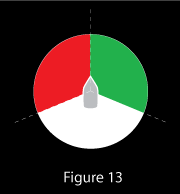
Sailing vessels underway (RULE 25): sidelights and sternlight - see Figure 13. Under 20m, these can be carried as a single "tri-colour" light at the top of the mast, which is a good idea because it takes less power and can be seen further away.
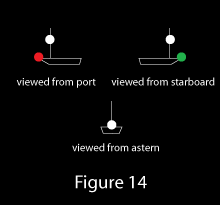 Power vessels underway (including sailing vessels when motoring) (RULE 23): sidelights, sternlight and masthead light. The masthead light (also known as a steaming light) needs to be placed higher than the sidelights. See Figure 14.
Power vessels underway (including sailing vessels when motoring) (RULE 23): sidelights, sternlight and masthead light. The masthead light (also known as a steaming light) needs to be placed higher than the sidelights. See Figure 14.
(If the vessel is less than 12m, it is allowed show an all round white light instead of the mastlight and sternlight.)
At anchor (RULE 30): none required if less than 7m, but otherwise an all round white light. In daytime, a ball.
Motoring with sails up in daytime (RULE 25): display a cone shape, with apex pointing down (at night, sidelights, sternlight and masthead light).
So if you are skippering a medium sized yacht, the lights you need are: sidelights and sternlight, and a white masthead light (steaming light) higher than those. You will also need an all round white anchor light. As an extra, you could carry a tri-colour at the top of the mast, which provides sidelights and sternlight for sailing, with only one bulb: less power and better visibility than deck level lights.
You need to carry two shapes: an anchor ball and a motoring cone.
Lights that Other Vessels Will Display
When you are at sea you will see vessels' lights, and from that you need to deduce what kind of vessel you are seeing, and what it is doing.
Single White Light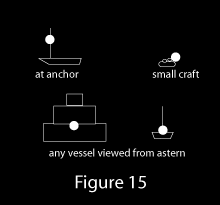
There are a number of possibilities that you need to be aware of, and you need to deduce what this is by taking other factors into consideration. It could be an anchor light (are you near an anchorage?) of a vessel less than 50m in length. It could be almost any vessel's sternlight (in which case, if you are getting closer to the light, you are probably overtaking them), or it could be a motor vessel less than 7m in length (more likely in sheltered waters close inshore; most vessels in the open sea would show sidelights).
See Figure 15. Note that if you are approaching any of these, you will have to keep out of their way.
Single Red or Green Light
 Normally a sailing vessel (RULE 25), and the light allows you to work out which side you are seeing and therefore roughly where it is heading (and perhaps which tack it is on).
Normally a sailing vessel (RULE 25), and the light allows you to work out which side you are seeing and therefore roughly where it is heading (and perhaps which tack it is on).
Incidentally, if you need to give way at night, the only way you can make it obvious to the other vessel that you have changed course is to make sure he can see your other sidelight.
See Figure 16. In this example, you can see another sailing yacht on your port bow, and the wind is on your starboard side. He is coming from the opposite direction, so he must be on port tack. This means he should give way. Initially you see his starboard sidelight, which means he is going to cross your track. Then when alters course to go behind you, you see his port sidelight and you know he has taken the required action.
Red or Green with White Masthead Light (Steaming Light)
 Power-driven vessel underway (RULE 23).
Power-driven vessel underway (RULE 23).
If there are two white masthead lights (also known as steaming lights) the vessel is over 50m in length, and the forward masthead light is lower than the aft one (both are higher than the sidelights). This makes it even easier to tell which side you are looking at.
Figure 17 shows examples.
Any one of those is simply a power-driven vessel, and for example is required to give way to a sailing vessel. If they have additional lights, they are telling us that they are one of the types of power-driven that sailing vessels have to give way to.
Other Lights and Shapes, and Their Meanings:
Vessel Engaged in Fishing (RULE 26) 
Vessels engaged in fishing exhibit two all round lights as follows: if trawling, green over white. If fishing other than trawling, red over white.
If they are making way through the water they also display sidelights and a sternlight, and if over 50m a higher masthead light further aft: just like normal power-driven vessels.
Figure 17 shows examples. The two all round lights take the place of the steaming light when they are making way through the water. In the daytime they show two cones one above the other, with their apexes pointing towards each other.
If the vessel has gear extending more than 150m from it, it will show an additional all round white light, or by day a cone pointing upwards, in the direction of the gear.
Vessel Not Under Command (RULE 27) 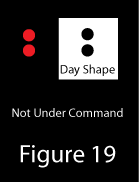
Like a fishing vessel, a vessel not under command (for a definition see previous section or RULE 3) is required to display two all-round lights is a vertical line: this time two red lights.
When making way through the water they also show sidelights and a sternlight.
The daytime shapes are: two balls in vertical line. See Figure 19.
Vessel Restricted in Ability to Manoeuvre (RULE 27) 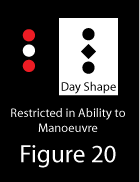
Vessel restricted in ability to manoeuvre show three all round lights in vertical line: red - white - red.
The daytime shapes are: ball - diamond - ball in vertical line. See Figure 20.
When making way through the water they also show the lights required for a power-driven vessel making way; similarly when anchored, they show the normal anchor lights described below, (in addition to the red white red all round lights).
Dredging / Underwater Operations - with Obstruction on One Side (RULE 27)
Sometimes a vessel restricted in ability to manoeuvre needs to tell other craft about an obstruction on one side and indicate that they should pass on the other. An example might be dredging in a narrow channel.
The obstructed side is indicated by two all round red lights or two balls in daytime; the clear side shows two all round green lights or two diamonds. See Figure 21.
Vessels Constrained by Their Draught (RULE 28) 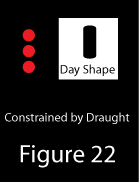
Vessels constrained by their draught show three all round red lights in vertical line, in addition to all the usual lights for a power-driven vessel underway.
The daytime shape is a cylinder. See Figure 22.
Divers (RULE 27)
 Some professional diving will take place from commercial vessels showing the lights and shapes for restricted in ability to manoeuvre and perhaps also for underwater operations on one side of the vessel, in which case you would be keeping clear anyway.
Some professional diving will take place from commercial vessels showing the lights and shapes for restricted in ability to manoeuvre and perhaps also for underwater operations on one side of the vessel, in which case you would be keeping clear anyway.
However, amateur diving from small vessels is very much more common. Look out for RIBs or small inflatables, or perhaps a medium sized motor boat, which could be some way off the shore and right in your path along the coast. They will be flying the A flag which means "I have a diver down: keep well clear" - or showing a rigid replica of it. See Figure 23.
Pilot Vessels (RULE 29)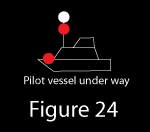
Because they need to approach and manoeuvre up to larger vessels, pilot vessels need to be readily identified at night. Their lights, when engaged on pilot duty, are: two all round lights, white over red. See Figure 24.
In addition they show sidelights and sternlight when underway, and normal anchor lights when at anchor.
If you are geeting confused between pilot boats and fishing boats, try this one:
"White over red, Pilot in bed: red over white, frying tonight".
Towing and Pushing (RULE 24)
This gets a bit complicated, not least because there are so ways to go about towing or pushing, and a variety of objects of differing sizes that may be manoeuvred in that way. Broadly, however, you probably don't need to remember every part of the rule in order to recognise that towing is happening, and to keep out of its way.
The simplest part of the rule is if a pushing vessel and vessel being pushed are rigidly connected, they are (quite sensibly) regarded as one power driven vessel and lit accordingly.
The Vessel Towing (or Pushing)
 Next a "normal" tow, with towing vessel in front pulling with a rope. The towing vessel is like a normal power driven vessel but with two white masthead lights instead of one. The masthead lights are placed in a vertical line.
Next a "normal" tow, with towing vessel in front pulling with a rope. The towing vessel is like a normal power driven vessel but with two white masthead lights instead of one. The masthead lights are placed in a vertical line.
If the length of the tow exceeds 200m from the sterm of the towing vessel, three white masthead lights; and also in this case, a diamond shape by day (there is also one of these on the towed vessel or object).
It also shows a yellow towing light in vertical line above the sternlight. See Figure 25.
Not shown on the figure: if the towing vessel is more than 50m long, like any other power-driven vessel it must show a second masthead light, higher and further aft.
A vessel pushing, or towing alongside, has the two masthead lights, but no yellow towing light (this is logical, because it clearly doesn't have the same danger astern of it).
The Vessel (or Object) Being Towed (or Pushed) 
The object or vessel being towed also needs to be lit.
If it is a vessel, towed behind or alongside, it shows sidelights and a sternlight. If it is being pushed ahead, just sidelights. If the length of the tow is more than 200m, the towed object displays a diamond, as does the object being towed. See Figure 26.
An object, or partially submerged vessel, will be lit by one or more all round white lights depending on the size. By day a diamond shape at the back and, if over 200m, at the front as well.
What if You Are Towing Something?
Professional organisers of tows should definitely not take this source as guidance, but should seek the exact text of the IRPCS! However, what do you do if, as skipper, you are obliged to tow something like another vessel behind your yacht, e.g. to rescue it?
The answer is that, if possible, you light the tow rope to show that the two vessels are connected.
Anchoring (RULE 30) 
Vessels less than 50m (and greater than 7m) need a single all round white light. Vessels more than 50m need two all round white lights, one forward and the second one lower down, aft. Very large vessels are also encouraged to turn on decklights. The day shape is a ball. See Figure 27.
If in addition you see: two all round red lights, or three balls, in vertical line, this means the vessel is aground (not required in vessels less than 12m).
